#university of minnesota press
Photo


A Cheerful-Sparrow Feathursday
Among the most cheerful birds in our neighborhood are the common House Sparrow (Passer domesticus) and the Dark-eyed Junco (Junco hyemalis). I wake up every morning with the House Sparrows on my porch telling me to chirrup! And as I walk to work, the Juncos flitting about close to the ground, with their white tail bars and their tiny chipping calls, just starts the day off right.
Both are sparrows, but the House Sparrow, a year-long resident here, is an Old World sparrow (family Passeridae), introduced into North America in the 1850s.The Junco is an indigenous New World sparrow (family Passerellidae). They breed much further north in summer, and while they do winter in our region, in Milwaukee I tend to see them only in spring and fall as they move through. For me, they are harbingers of the changing seasons.
The images shown here are from a 1930 painting by American nature artist Walter Alois Weber reproduced in Bird Portraits in Color by the American physician and ornithologist Thomas Sadler Roberts and published by the University of Minnesota Press in the 1934. The volume includes 92 color plates by five wildlife artists illustrating 295 North American species.
The two birds in the upper left of this plate are male breeding adult and fall immature male Juncos; in the upper right are male and female House Sparrows; at bottom on the ground are female breeding adult and juvenile Juncos.
View other posts from Bird Portraits in Color.
View more Feathursday posts.
-- MAX, Head, Special Collections
#Feathursday#sparrow speaks#Old World sparrows#New World sparrows#House Sparrows#Dark-eyed Junco#Bird Portraits in Color#Walter Alois Weber#Thomas Sadler Roberts#University of Minnesota Press#bird paintings#wildlife art#biological illustration#birds#birbs!
609 notes
·
View notes
Text

Elias Khoury (1981) (الياس خوري), Gates of the City, Foreword by Sabah Ghandour, Translated by Paula Haydar, University of Minnesota Press, Minneapolis, MN, 1993 [Rare Book Cellar, Pomona, NY]

#graphic design#book#cover#book cover#elias khoury#sabah ghandour#paula haydar#university of minnesota press#1980s#1990s
13 notes
·
View notes
Text
Jonathan Cott — Let Me Take You Down: Penny Lane and Strawberry Fields Forever (University of Minnesota Press)
youtube
Whether you adore, loathe, or are indifferent to the Beatles, it seems fair to ask in 2024 what exactly could be left to say about them. Surely at this point the most written about, discussed, mythologized, demythologized, simply covered band (although to be fair, have they blown up on TikTok yet?), it’s understandable both that people would feel compelled to express themselves about the Beatles and that the rest of us might have our eyes glaze over in response. Jonathan Cott has more bona fides in this area than most, having written about and interviewed the band from the 1960s on (including an interview with John Lennon a few days before his murder), and he’s made two smart choices in putting together this particular book: narrowing the focus, and going in a more idiosyncratic, personal direction.
That focus is apparent from the title on down, and it’s a relief to see the scope reduced to two songs. Who needs another general overview of this particular band? (Yes, it’s good those exist in general, there will always be new, curious people as time passes, but it feels like that category is pretty densely populated at this point.) The Beatles are also one of the few acts that could conceivably sustain (in a financial sense) a whole book on one of their singles, even a double A side; even if one wished various other artists would get that kind of analysis, it’s hard to begrudge writers taking their chance to go so deep on one of their few chances to do so. But Let Me Take You Down is only partly a history of the two songs. The first section here covers, in 50 pages, the circumstances of the two songs’ creation, looking at the first period where the four members tried taking a break from the Beatles (and, in some cases, had existential crises about what not being a Beatle might mean), Lennon and McCartney’s artistic partnership/slight rivalry, the personal history that fed into both songs, and so on. It’s well done and moves briskly; someone who knew nothing about the Beatles would probably come away wanting to know more, and those already deeply steeped in the lore won’t feel their time has been wasted.
The second and final section here is nearly twice as long as the first; Cott, clearly a seasoned interviewer (with an impressive ability to either quote other myriad other works and authors out of thin air, or an impressive dedication to keeping potentially relevant quotations on hand to refer to), sits down with “five remarkable people” to discuss the single. Only two of them, Laurie Anderson and Bill Frisell, are primarily known as musicians. The three are the urban planner and Gramavision Records founder Jonathan F. P. Rose, Jungian analyst Margaret Klenck, and actor (and, more significantly for his section, noted Buddhist) Richard Gere. These conversations feel like they make up the heart of the book, and are where it will succeed or fail for most readers.
The tone throughout all five conversations is loose and friendly, with everyone involved engaging with the songs (lyrics, sound, historical context, personal context) deeply but informally. It’s worth noting that the median age of all six interlocutors is in the early 70s, and all come at “Strawberry Fields Forever”/“Penny Lane” from the perspective of people who were there at the time and who’ve been playing and thinking about these two particular songs ever since. Although Cott does have a bit of a thesis (based on James Hillman’s The Dream and the Underworld, with Paul as Zeus taking you “back” and John as Hades taking you “down”), he doesn’t impose it on any of the conversations and they all go in their own directions. Are these songs about depression? memory? love? the illusion of the self? all of the above? Let Me Take You Down’s most signal virtue is the way it might remind you of your own deep conversations with friends about music (Beatles or not), digging deeply into shared passions and volleying insights and theories back and forth.
The result is a book both small and scope but that goes to surprising places. If there are quibbles to be had, they’re along the lines of wishing “Penny Lane” got as much space from any of the people involved as “Strawberry Fields Forever” (but then again, isn’t the underworld something most of us find more fascinating, and easier to talk about, than our pasts?), and that the dense repetition of “said,” “explained,” “commented,” etc. might make one wish these interviews were presented in a more transcript-like style. Those small issues aside, the only big issue Let Me Take You Down really has is the obvious one, that most can answer for themselves instantly: in 2024, do you want to read another book about the Beatles?
Ian Mathers
#jonathan cott#let me take you down penny lane and strawberry fields forever#university of minnesota press#ian mathers#bookreview#dusted magazine#the beatles#history#pop#psychedelia#bill frissell#laurie anderson#psychology
6 notes
·
View notes
Text

Profit over Privacy, Matthew Crain, University of Minnesota Press, 2021
0 notes
Text
Sam and the Incredible African and American Food Fight by Shannon Gibney, illustrated by Charly Palmer
Sam and the Incredible African and American Food Fight by Shannon Gibney, illustrated by Charly Palmer. University of Minnesota Press, 2023. 9781517909659
Rating: 1-5 (5 is an excellent or a Starred review) 5
Format: Picture book, advanced reading copy (publication date 4/23)
What did you like about the book? As Sam entered his kitchen after school, the Incredible African and American food…

View On WordPress
0 notes
Text

(link)
(@mitigatedchaos)
7 notes
·
View notes
Text
The Minnesota House voted 70-58 along party lines Thursday to spend around $200 million a year making school breakfasts and lunches available to all students at no cost.
Debate over universal school meals has inverted the usual partisan talking points, with Republicans in this case railing against what they call a taxpayer-funded giveaway to the rich.
More than one-third of Minnesota public school students already get free school meals because of their low family income or high poverty rates in their schools. The DFL-led legislation would offer free meals, regardless of income, to every student at schools that participate in the National School Lunch Program, including private schools.
“Why are we feeding kids in Edina or rich areas that do not need this extra funding? We are pushing tax dollars where they are not needed,” said Rep. Pam Altendorf, R-Red Wing.
Republican lawmakers tried but failed to amend the bill Thursday by somewhat expanding eligibility for free school meals – to 250% of the federal poverty level, up from 185% – without making them free for all students.
“We do need to feed our children, but we have to do this in a reasonable, fiscally responsible way,” said Rep. Krista Knudsen, R-Lake Shore.
The bill’s sponsor, Rep. Sydney Jordan, DFL-Minneapolis, said one-quarter of hungry kids in Minnesota don’t qualify for free school meals under the federal income guidelines. She waved off concerns about funding meals for families that can afford to pay.
“We give every kid in our school a desk. There are lots of kids out there that can afford to buy a desk, but they get a desk because they go to school,” she said.
One hangup for school leaders is the impact that universal school meals might have on the collection of meal-subsidy application forms, which determine how much extra money schools get for a variety of programs.
“I’ve had countless conversations with my administrative colleagues, and they don’t want this,” said Rep. Ben Bakeberg, R-Jordan, a middle school principal.
Another bill, which was introduced Thursday, aims to address that concern by replacing those forms with other methods of assessing concentrations of poverty.
“This is something that we’re very much aware of and working with right now,” said Rep. Laurie Pryor, DFL-Minnetonka.
Congress provided free school meals to all students for two school years during the coronavirus pandemic, but that funding stopped last year. Five states are picking up the food bill for their students this school year, and two of them are doing so permanently; a third, Colorado, will join them next year after voters approved a ballot measure.
Gov. Tim Walz supports making Minnesota the fourth state to permanently provide universal school meals. A companion bill awaits action by the finance committee in the DFL-controlled Senate, where the sponsors include Assistant Minority Leader Zach Duckworth, R-Lakeville.
#us politics#news#St. Paul Pioneer Press#Minnesota#2023#Minnesota house of representatives#universal school meals#free school lunches#National School Lunch Program#Pam Altendorf#Krista Knudsen#Sydney Jordan#impoverished children#Zach Duckworth#Gov. Tim Walz#Minnesota senate
26 notes
·
View notes
Note
are there any books i can read to learn more about university abolition?
Fred Moten and Stefano Harney, The Undercommons: Fugitive Planning and Black Study (Brooklyn: Minor Compositions, 2013) [link: open access pdf]
Dylan Rodriguez, “Racial/colonial Genocide and the Neoliberal Academy: In Excess of a Problematic.” American Quarterly 64.4 (2012)
la paperson, A Third University Is Possible (Minneapolis: University of Minnesota Press, 2017)
The Imperial University: Academic Repression and Scholarly Dissent. Edited by Piya Chatterjee and Sunaina Maira. Minneapolis: University of Minnesota Press, 2014
Review essay: "Critical University Studies and the Crisis Consensus." Abigail Boggs and Nick Mitchell. Feminist Studies 44 (2): 432-463 (2018)
Clyde W. Barrow, Universities and the Capitalist State: Corporate Liberalism and the Reconstruction of American Higher Education, 1894-1928 Madison: University of Wisconsin Press. 1990
Eli Meyerhoff, Beyond Education: Radical Studying for Another World (Minneapolis: University of Minnesota Press, 2019).
419 notes
·
View notes
Text
Hey guys what's up I learned bookbinding to make @cindthia a physical copy of Synchronized Cardioversion for our anniversary :3
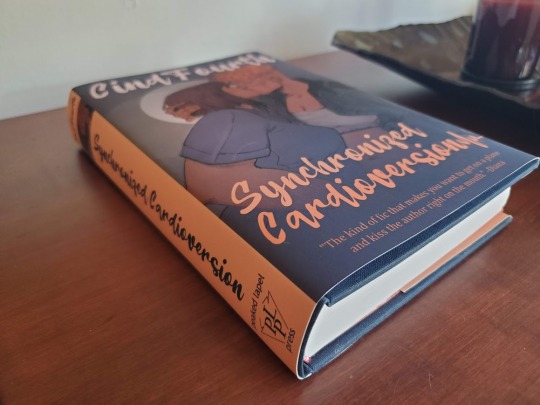
Pics and process documentation below!
I used the following resources:
How to Make a Book by ArmoredSuperHeavy
Bookbinding Resources Master List by Renegade Bindery
r/Fanbinding
the fanbinding tag on AO3 - shoutout to r3zuri's fanbinding of a FFVII fic for their extremely informative cliff's notes version of the process
the Intro to Hand Bookbinding class at the Minnesota Center for Book Arts, an incredible resource for anyone in or near Minneapolis interested in learning how to bind their own books.
First, I typeset the fanfic. I did this by downloading it from AO3, trying to figure it out myself, checking How to Make a Book for help with a problem I was having, and realizing that I should have just used it from the beginning in the first place. I used Microsoft Word 2013.
Fonts: Palatino Linotype, Helvetica (for the characters' text messages), Beatline (for titles)
Margins: .88" top, 1" bottom, .75" inside, .75" outside, .25" gutter
Front matter:
- Title page with only the title
- "Praise for Synchronized Cardioversion" with comments from the fic
- Title page with title, author name, and a colophon I made
- Copyright page with fic copyright, fic URL, TLT series copyright, disclaimer, AO3 fic summary, first chapter author's notes, copyright for in-text art, book design credit, font info
Back matter:
- Acknowledgments (from the fic)
- "Also by CindFourth" with all their TLT fic separated into Synchronized Cardioversion Extended Universe (might make another book of this at some point); Other Camgideon, Campal, and Team 69; and Other Locked Tomb
I set the page layout to "book fold" with 16-page signatures. As for the art, one of Cind's requests in last year's TLT Holiday Exchange was for art of this fic and they got not only a fantastic one-page comic from their assigned creator, our friend @anaeolist (who also did a sketch of Cam and Gideon kissing - we'll come back to that later), but also a lovely piece as a treat from our friend @kat-hikari. I got permission from both artists to include their work in the book.
The finished file was 408 pages, so I added four blank pages (two sheets) to the beginning and the end to make 26 signatures even.
Next, I printed the pages. I used my Brother DCP-L2550DW and Hammermill 11x8.5 24/60 lb. cream bookbinding paper from Church Paper. I'd read that sometimes using short-grain paper in a regular printer could cause it to jam, but it went fine. The cream color made the pages look so professional.

I folded the pages into signatures and then pressed them overnight. Since I don't have a book press, I sandwiched them between two sheets of bookboard and put a heavy box on top, and that worked well.


The next step, punching holes and sewing, was my favorite. I'd made a punching cradle using instructions I got in my bookbinding class. It was a lot easier than I thought it would be, and it only used bookboard and PVA glue, so I didn't even need to buy anything I hadn't already bought for the project.


I used three pieces of tape and sewed them on using a kettle stitch.

Then I went to MCBA to use their guillotine on the text block and their board shear to cut boards for the cover.


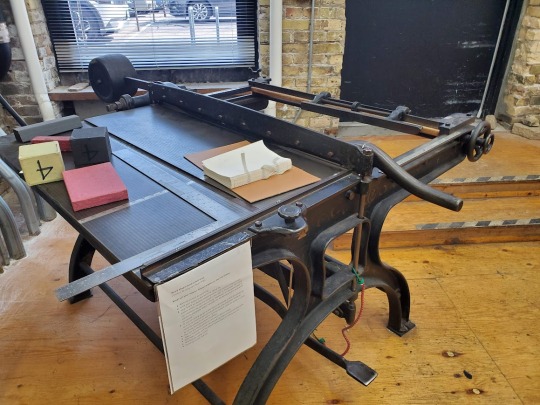
I chose orange cardstock for the endpaper, and because I am a novice making novice mistakes I unfortunately forgot to get a size of cardstock that would let me fold it on the grain, but anyway. I trimmed it to the exact size of the pages and glued it to the text block. Next I glued the spine of the text block, rounded it a bit (not the way an expert would; you learn that in Intermediate Hand Bookbinding), added a strip of super mull and headbands at either end, and sat it under a weight to dry while I made the cover.

The Bristol board I cut for the spine was probably 1/8" too wide, which makes a bigger difference than you would think. Next time I'm going to err on the side of slightly too narrow when I'm already giving myself three board widths of a buffer on either side.

Aside from that, the cover turned out great! I could have done a better job lining up the endpaper when I glued it in, but that's the kind of thing you practice I guess.
I love the way the navy blue bookcloth looks with the cream paper, the orange endpaper, and the red and white headbands.
Now that I had the exact dimensions of the book, I could finally design the dust jacket. Remember that sketch of Cam and Gideon kissing that anaeolist did for the holiday exchange? I commissioned them to turn it into a finished piece for the cover, and boy did they ever deliver. I also asked some of our other friends who had read the fic to give me blurbs for the back cover, and they delivered too. Cind's and my relationship wouldn't have been possible without the wonderful community we met in and I wanted this gift to reflect that.

I created the jacket in GIMP at a print resolution of 300ppi and saved it as a pdf. The final step was to get it printed, which I was nervous about because it was the only part of the process that I had no control over at all. Long story short, I ended up with something I was very happy with done by a small chain print shop where I had to go in and talk to a human about what I needed.
I also posted this to AO3!
110 notes
·
View notes
Text
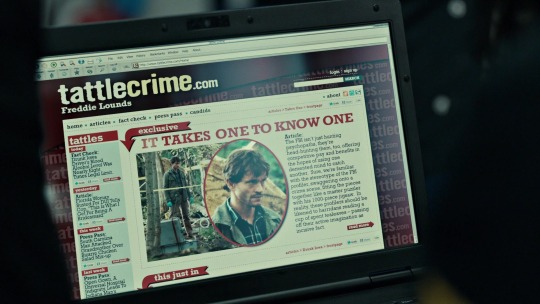
It takes one to know one
Article: The FBI isn't just hunting psychopaths, they're head-hunting them too, offering competitive pay and benefits in the hopes of using one demented mind to catch another. Sure, we're familiar with the stereotype of the FBI profiler, swaggering onto a crime scene, fitting the pieces together like a master puzzler with his 1000-piece jigsaw. In reality, these profilers should be likened to harridans reading a cup of spent tealeaves- passing off their active imagination as incisive fact.
Fact Check: Drunk Iowa Driver's Alcohol Level Was Nearly Eight Times Legal Limit
Article: Florida Woman Busted For DUI Tells Cop, "This Is What I Get For being a bridesmaid"
Press Pass: South Carolina Man Attacked Grandmother Over Bizarre Chick Salad Mix-Up
Press Pass: Open Gown, A Universal Hospital Indignity, Leads To Indiana Man's [unreadable]
Another Shrike In the Nest?
by Frederica Lounds
As reported before by Tattlecrime, the FBI maintains jurisdiction in the case of Garret Jacob Hobbs, the Minnesota Shrike. But as days turn to weeks, desperation has begun to take hold amongst the investigators. An embarrassing truth is beginning to emerge: There are no new leads on the whereabouts of the Shrike's seven missing victims. As families await any word at all about their lost daughters, the case looks as though it has stalled. Tip lines are open, but they have so far yielded little to nothing. Where lie these poor women who deserve a proper funeral?
When approached for comment on the investigation, things with Graham took a surprising and dark turn. Upset at the probity of the questions at hand, Graham threatened, "It's not very smart to piss of a guy who thinks about killing people for a living." A statement like this calls into question the very mind and method of Will Graham and his FBI apologists. This is a man who skirted normal FBI... Read More
It Takes One To Catch One?
PHOTO EXLUSIVE - INSIDE THE LEEDS HOME
Exclusive photos of house where the Jacobi family was slaughtered.
The Jacobi home nestled in a sleepy suburb of Chicago that was startled awake by the shocking murder that has changed the area forever. Residents that have lived in the area for almost twenty years have said that they will now consider moving. See the disturbing exclusive photos inside.
Insane Fiend Consulted in Mass Murders by Agent He Tried To Kill
by Freddie Lounds
FEDERAL MANHUNTERS, stymied in their search for the Tooth Fairy, have turned to the most savage killer in captivity for help. Hannibal the Cannibal has gotten a call from a very special visitor- none other than Will Graham himself.
I saw it with my own eyes, Graham coming form the main entrance to the Baltimore State Hospital for the Criminally Insane on a recent afternoon. This mysterious visit had this reporter curious to its nature. What could Graham, who was almost a victim of Lecter himself, have to discuss with the Mad Doctor?
A bit more digging lead me to face to face discussion with Will Graham. Needless to say he was evasive. But I was able to suss out that Graham has begun working for the FBI again on the Tooth Fairy investigation. And he was in fact visiting Lecter to help him get information on the Tooth Fairy murders.
Is this really where to FBI has sunk? Hiring a man with questionable stability to get information form a clinically insane psychotic? If this is where the FBI has been able to take this investigation, this reporter is worried. Worried for the family left behind by the Leeds and Jacobi murders. And worried for the next family on whatever deranged list the Tooth Fairy has made. For surely there will be a next family. There have been three so far the the Tooth Fairy shows no sign of stopping. And frankly- what's to stop him? Certainly no local police agencies. Certainly no the FBI who have done nothing to further the investigations since they took over several months ago.
CANNIBAL KILLER FEEDS THE FEDS
[alt] FBI IN BED WITH THE DEVIL
[alt] TOOTH FAIRY INVESTIGATION BUNGLED BY FEDS?
Desperation Leads to Partnership with Cannibalistic Killer
The recent apparent partnership between the FBI and Hannibal Lecter has this reporter wondering if there is anyone with whom the FBI won't partner. One wonders the validity of whatever information can be gleaned from someone who is so clinically insane as to devour those around him.
How much can Lecter be trusted not to give misleading information to protect perhaps a fraternity of killers with whom he would most definitely be a member. And what does Lecter get from all this? Special privileges? Or maybe just the excitement of getting inside information on the violent nature of the Tooth Fairy crimes. This would no doubt a source of great pleasure for someone so diabolical in nature.
I wonder how this makes the families of the victims feel. To know that Hannibal the Cannibal is drooling over the bloody remains of the lost loved ones. Is whatever little information can be provided by this this 'expert' killer worth making the victim's families continue to suffer?


#nbc hannibal#freddie lounds#will graham#hannibal lecter#freddie lounds articles#tattlecrime#tattle crime#Hannibal details
101 notes
·
View notes
Text
A Minnesotan Sizes Up Tim Walz
During his tenure, student achievement has slipped, crime has surged, and state residents have fled.
By Scott W. Johnson - Wall Street Journal
St. Paul, Minn.
Tim Walz has such a bad record as Minnesota’s governor that I was astonished when he landed on Vice President Kamala Harris’s vice-presidential shortlist. As Minnesota’s Center of the American Experiment has documented, under Mr. Walz Minnesota has become a high-crime state. Student achievement has tumbled as spending on schools has skyrocketed. Per capita gross domestic product has fallen below the national average. Minnesotans have joined residents of New York, California and Illinois in fleeing their home state.
Pennsylvania Gov. Josh Shapiro—also on Ms. Harris’s shortlist—made sense to me. Pennsylvania is a key state. Mr. Shapiro seems to be a man of substance and would give liberal Jews a reason to vote for Ms. Harris without a guilty conscience. As a Jewish supporter of Israel, I worried that Mr. Shapiro would give the animus throbbing in the heart of the Democratic Party cover. Indeed, that animus drove a nasty intraparty campaign against him.
But Tim Walz? I’m a conservative Republican. I don’t completely understand Democrats’ ways. As an observer of Minnesota politics, however, I understand how Mr. Walz became governor. Having served six terms in Congress from a rural district, he challenged the endorsed DFL (Democratic-Farmer-Labor Party) candidate—a liberal metro-area state senator, Erin Murphy—in the 2018 DFL primary. Ms. Murphy was also challenged by another metro-area liberal, Lori Swanson, then state attorney general. With Ms. Murphy and Ms. Swanson dividing the liberal urban vote, Mr. Walz and his far-left running mate, former state Rep. Peggy Flanagan, won the primary with 41%.
On taking office in 2019, Gov. Walz was restrained by a one-seat Republican majority in the state Senate—until Covid hit in the spring of 2020. He declared a state of emergency on March 25, 2020, and ruled by decree for 15 months. He proclaimed the emergency on the basis of an allegedly sophisticated Minnesota Model projection of the virus’s course in the state. In fact, the projection reflected a weekend’s work by graduate students at the University of Minnesota School of Public Health. Relying on their research, Mr. Walz presented a scenario in which an estimated 74,000 Minnesotans would perish from the virus. The following week the Star Tribune reported that with the lockdown Mr. Walz ordered, 50,000 would die. Maybe it would have been preferable to address the virus through democratic means.
Having destroyed jobs and impeded life routines, including family get-togethers and church attendance, Mr. Walz finally let his one-man rule lapse on July 1, 2021. When the Johns Hopkins Coronavirus Resource Center stopped counting in March 2023, the deaths of 14,870 Minnesotans were attributed to the virus. (In 2020 I successfully sued the administration for excluding me from Health Department press briefings on Covid.)
During the state of emergency, protests broke out in Minneapolis on Memorial Day 2020 following the death of George Floyd. That Thursday, rioters burned Minneapolis’s Third Precinct police station to the ground. Mr. Walz didn’t deploy the National Guard until the weekend. Riots, arson and looting throughout the Twin Cities caused about $500 million in damage.
Minnesota leads the nation in Covid fraud. Under the auspices of the Feeding Our Future nonprofit, its founder, Aimee Bock, allegedly recruited mostly young Somali men to seek reimbursement for millions of meals supposedly served to poor students and families. According to indictments handed up by a grand jury to U.S. Attorney Andrew Luger, Ms. Bock and others allegedly defrauded the state and federal government of $250 million. Ms. Bock has pleaded not guilty to the fraud charges.
Among the 70 defendants charged to date, 18 have pleaded guilty. In April the first of the cases to go to trial had seven defendants; five were convicted. The remaining cases have yet to be tried. In all, the Minnesota Department of Education oversaw the payout of $250 million to reimburse fictitious meals. The nature and scale of the fraud are staggering. Mr. Walz tried to blame state district court judge John Guthmann, who in April 2021 handled a case regarding the department’s processing of applications for reimbursements. According to Mr. Walz, Judge Guthmann ordered the state to continue payouts to the alleged perpetrators of the fraud even after the state Education Department discovered it.
In September 2022, Judge Guthmann authorized a news release titled “Correcting media reports and statements by Gov. Tim Walz concerning orders issued by the court.” The release concluded: “As the public court record and Judge Guthmann’s orders make plain, Judge Guthmann never issued an order requiring the MN Department of Education to resume food reimbursement payments to FOF. The Department of Education voluntarily resumed payments and informed the court that FOF resolved the ‘serious deficiencies’ that prompted it to suspend payments temporarily. All of the MN Department of Education food reimbursement payments to FOF were made voluntarily, without any court order.”
In November 2022 Mr. Walz was elected to a second term, and the DFL won majorities in both chambers of the Legislature. In the preceding two years the state had accumulated an $18 billion budget surplus. With the DFL in full control, Mr. Walz and the Legislature have spent the $18 billion surplus on infrastructure, education and other programs that will burden the state for years. They have also raised taxes.
Mr. Walz and his DFL colleagues have backed measures establishing Minnesota as a mecca for abortion and a “trans refuge.” The legislation prohibits enforcing out-of-state subpoenas, arrest warrants and extradition requests for people from other states who seek treatment that is legal in Minnesota. It also bars complying with court orders issued in other states to remove children from their parents’ custody for authorizing hormone treatment or surgery to alter sex characteristics.
Like so many Democrats who have kept up with the demands of the progressive agenda, Mr. Walz has “grown” in office. In his second term, he has been the most left-wing Minnesota governor since the socialist Floyd B. Olson (1931-36). I doubt that Mr. Walz could be elected to Congress in his old district, which is now represented by a Republican. The idea that he can appeal to voters who don’t already support Ms. Harris seems far-fetched.
Mr. Johnson is a retired Minneapolis attorney and contributor to the site Power Line.
#Tim Walz#minnesota#Democrats#kamala harris#Obama#Biden#Corrupt#trump#trump 2024#president trump#ivanka#donald trump#america#americans first#america first#repost#corruption kink#government corruption#democrats are corrupt#biden corruption#impeach#maga
76 notes
·
View notes
Text






A Cardinalidae Feathursday
The Cardinals (Cardinalis cardinalis) and Rose-breasted Grosbeaks (Pheucticus ludovicianus) in our neighborhood have just been chattering away this early summer. The call of the Cardinal is quite distinctive, but we often confuse the call of the Rose-breasted Grosbeak with that of the American Robin. Some say the Grosbeak sounds like a Robin that has had better music lessons, but we have a hard time telling them apart. What do you think?
Both are members of the family Cardinalidae. The only other species in that family that lives in our area (that we know of) is the Scarlet Tanager (Piranga olivacea), which also sounds remarkably like a Robin, but hoarser. The images shown here are from a 1930 painting by American nature artist Walter Alois Weber reproduced in Bird Portraits in Color by the American physician and ornithologist Thomas Sadler Roberts and published by the University of Minnesota Press in the 1934. The volume includes 92 color plates by five wildlife artists illustrating 295 North American species.
The three birds in the upper left of this plate are winter male, female, and male nestling Rose-breasted Grosbeaks; in the upper right are a fully adult breeding male and first-year breeding male Rose-breasted Grosbeaks; at bottom are adult female and male Cardinals.
View other posts from Bird Portraits in Color.
View more Feathursday posts.
#Feathursday#Northern Cardianls#Rose-breasted Grosbeaks#Cardinalidae#Bird Portraits in Color#Walter Alois Weber#Thomas Sadler Roberts#University of Minnesota Press#bird paintings#wildlife art#biological illustration#birds#birbs!
62 notes
·
View notes
Text

Leanne Betasamosake Simpson, As We Have Always Done. Indigenous Freedom through Radical Resistance, University of Minnesota Press, Minneapolis, MN, and London, 2017



Cover Art: © Lianne Marie Leda Charlie
#graphic design#book#cover#book cover#leanne betasamosake simpson#dechinta centre for research and learning#university of minnesota press#2010s
10 notes
·
View notes
Text
Nate Patrin — The Needle and the Lens: Pop Goes to the Movies From Rock ’n’ Roll to Synthwave (University of Minnesota Press)

youtube
For all that we tend to think of the early years of cinema as “silent” films, the movies has always had a close relationship to sound and music (right down to bringing live performers in). The disciplines of scoring and sound design are integral to the vast majority of most modern film, but here critic Nate Patrin singles out another, related practice: the needle drop. His focus in The Needle and the Lens is specifically on those cases where movies have used (and sometimes tried to ride the coattails of, in various ways) pre-existing songs, rather than anything composed specifically for them. This leaves out some of the truly great soundtrack songs that might spring to mind (“Fight the Power” was written for a movie!) but allows Patrin to tell the more specific story of the ways both movies and music over the years have looked to the other medium for elements they could take for themselves (whether that’s cultural prominence, marketing tips, or aesthetic gambits).
Arranged in a series of movie/song pairs covering the 1960s to the 2000s in the main chapters (and in a highly enjoyable bonus round of 24 more picks, going all the way to 2020), Patrin starts each chapter by vividly describing the way the film in question uses the song he’s chosen. He then proceeds through a history of the creation of both parts of the equation, and how they wound up together (ranging from serendipitous to torturous). Along the way he includes enough thought provoking context to continually throw up interesting questions without getting in the way of the overall narrative of the book. Ones like, did Kenneth Anger make the first modern music video? Does Quentin Tarantino understand the relationship between nostalgia and camp? Is David Lynch somehow responsible for the Traveling Wilburys?
While each chapter is as distinct as its source material, Patrin also skillfully crafts a throughline that ties them together. He shows that, while any individual director, producer, music supervisor, etc. may have been making idiosyncratic choices when it comes to picking songs for their movies, there is an overarching story to tell about how Hollywood as a whole came to understand the value of using existing songs, music that the audience already brought a level of personal and emotional association to. And while in some ways we may be past the golden age of the needle drop (when was the last time a soundtrack album that wasn’t a score or other new material was a big deal, culturally?), The Needle and the Lens makes a case for why so many of us have fond memories of them, and continue to react so strongly to good ones. Maybe the most compelling point in the book’s favour is just how many of Patrin’s chosen moments and his writing on them make you want to watch (or rewatch) them.
Ian Mathers
#nate patrin#the needle and the lens#pop goes to the movies from rock 'n' roll to synthwave#university of minnesota press#ian mathers#bookreview#dusted magazine#soundtracks#history#pop
4 notes
·
View notes
Text
university of minnesota press is having a 40% off sale on these topics until september
26 notes
·
View notes
Text
Don’t Count Your Chicks by Ingri & Edgar Parin d’Aulaire
Don’t Count Your Chicks by Ingri & Edgar Parin d’Aulaire
Don’t Count Your Chicks by Ingri & Edgar Parin d’Aulaire. University of Minnesota Press, 2023. 9781517914462 (c1943 Doubleday, Doran & Company)
Rating: 1-5 (5 is an excellent or a Starred review) 5
Format: Hardcover picture book
What did you like about the book? First published in 1943 (!) this story has lost none of its poignancy, humor, charm or words of wisdom. A woman has one hen and a…

View On WordPress
0 notes